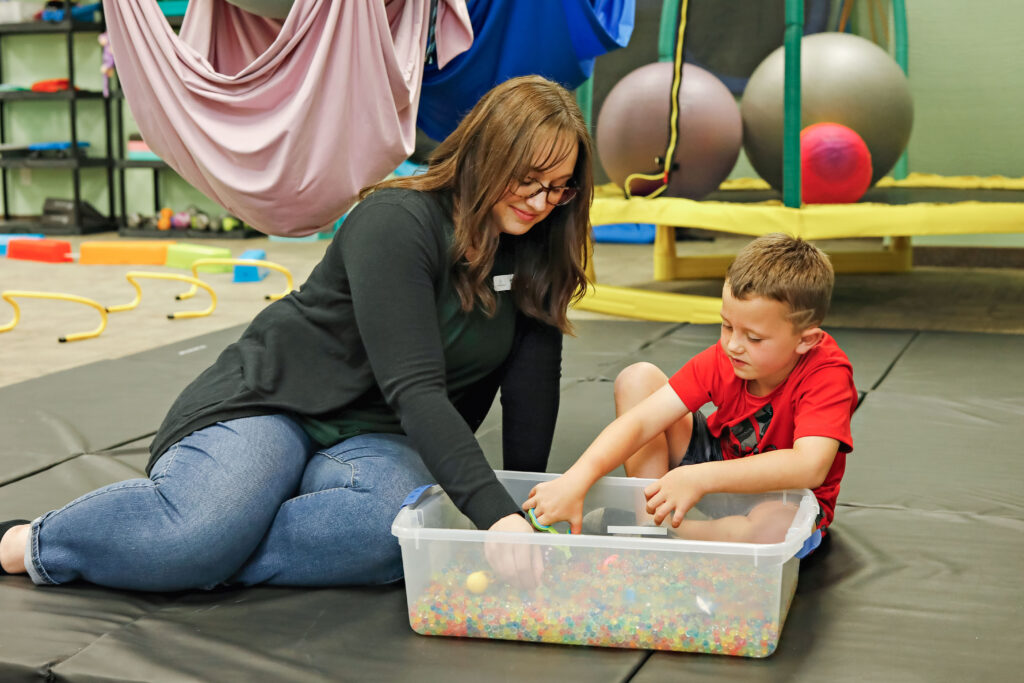
We have had many reports over the past week of increased difficulty with bedtime and morning routines due to children having increased behaviors with going to bed, difficulty falling asleep, or difficulty getting out of bed.
Sleep is essential for children’s growth, development, and overall well-being. However, for many children, particularly those with sensory processing issues, autism spectrum disorder (ASD), attention-deficit/hyperactivity disorder (ADHD), or other developmental challenges, achieving a restful night’s sleep can be difficult. Pediatric Occupational Therapy (OT) can play a crucial role in helping children develop healthy sleep habits, improve sleep quality, and address the underlying sensory or behavioral factors that interfere with sleep.
The Importance of Sleep for Children: Sleep is not just a time for rest; it’s when the body and brain undergo crucial processes that promote cognitive function, emotional regulation, and physical development. Children, especially infants and toddlers, require more sleep than adults:
- Infants (4-12 months): 12-16 hours per day
- Toddlers (1-2 years): 11-14 hours per day
- Preschoolers (3-5 years): 10-13 hours per day
- School-age children (6-12 years): 9-12 hours per day
- Adolescents (13-18 years): 8-10 hours per day
Common Sleep Challenges in Children: A variety of factors can disrupt a child’s sleep, including:
- Sensory Sensitivities: Children with sensory processing issues might be sensitive to light, sound, textures, or temperature, which can interfere with their ability to fall asleep or stay asleep.
- Anxiety or Stress: Worries, fears, or stressful life events (e.g., family changes, school transitions) can lead to difficulties falling asleep or frequent night waking. 3. Behavioral Issues: Children with ADHD or other behavioral conditions might struggle with hyperactivity, impulsivity, or difficulty winding down before bed.
- Sleep Associations: Children may develop sleep associations (such as needing to be rocked or held to fall asleep) that make it harder for them to self-soothe and fall asleep independently.
- Change in Schedules: Holidays, spring break, and other changes in a child’s schedule can cause changes in overall routine.
- Medication Changes: It is important to ask your child’s pediatrician or psychiatrist what impact your child’s medication may have on their ability to fall and stay asleep.
Recommendations from Little Legends Therapy Pediatric OT to Improve Sleep 1. Creating a Sensory-Friendly Sleep Environment:
For children with sensory sensitivities, the sleep environment can play a significant role in promoting sleep. OTs may recommend adjustments such as:
- Lighting: Soft, dim lighting or blackout curtains can help children who are sensitive to light.
- Sound: White noise machines or soft music can mask background noise, helping children who are sensitive to sound.
- Texture and Comfort: OTs can suggest appropriate bedding, like soft sheets, weighted blankets/stuffed animals, or “huggie” sheets to provide comfort and security. ● Temperature Regulation: Ensuring the room is at a comfortable temperature (typically between 65-70°F) helps children who may be sensitive to heat or cold.
- Establishing a Consistent Sleep Routine:
Children thrive on routine, and having a predictable bedtime schedule can help signal to the body that it’s time to wind down. OTs may work with parents to establish a consistent routine that includes calming activities such as:
- Deep pressure touch: Activities like firm hugs, joint compressions, or using a weighted blanket can help promote relaxation.
- Calming Activities: Activities like reading a book, listening to soft music, or engaging in quiet play (e.g., drawing, puzzles) can be included in the pre-sleep routine and help the body signal to “wind-down” before bed.
- Relaxation Techniques: Deep breathing exercises, progressive muscle relaxation, or guided imagery can help children self-regulate and manage anxiety or restlessness. ● Exposure to Blue light: Exposure to Blue light interferes with the body’s natural production of melatonin. It is important to limit exposure 30-60 minutes before bed. ● Select a regular bedtime and wake up time: This helps regulate the body’s internal clock, assisting in improving sleep patterns.
- Self-Regulation and Relaxation Strategies:
For children with ADHD, anxiety, or sensory processing challenges, learning self-regulation techniques can improve their ability to fall asleep independently. Occupational therapists teach various techniques to help children calm their bodies and minds:
- Heavy Work Activities: Physical activities like carrying heavy objects or jumping on a trampoline help children use their proprioceptive system to regulate their bodies and prepare for sleep.
- Breathing Exercises: Simple breathing exercises, such as “bunny breathing” (sniffing through the nose and exhaling through the mouth) can help children calm their nervous system before bed.
- Body Scanning: Encouraging children to notice how their body feels and consciously relax each part of their body can reduce tension and promote a restful state.
- Diet and Nutrition
- Avoid caffeine: Limit caffeinated beverages (e.g., soda, chocolate, tea) in the late afternoon and evening, as they can interfere with sleep.
- Light evening meals: A heavy or rich meal close to bedtime can cause discomfort and hinder sleep. A light, balanced meal is better.
- Hydration: Ensure adequate hydration throughout the day, but reduce fluid intake near bedtime to minimize the likelihood of needing to use the bathroom during the night. ● Eat foods high in Magnesium:Magnesium is known to aid in relaxation and sleep. Here is a list of foods to eat prior to bed/
○ Bananas
○ Whole grains: bread and oats
○ Almonds and cashews
○ Dark chocolate
○ Yogurt
- Behavioral Strategies
- Gradual Adjustments: If the child has developed an irregular sleep pattern, consider using a gradual approach to adjust bedtime. Shift bedtime earlier by 10-15 minutes every few days until the desired bedtime is reached.
- Positive Reinforcement: Use rewards and praise for sticking to the bedtime routine or staying in bed all night. Establish clear and consistent consequences for not following the routine, if needed.
- Utilize Visual Schedules and timers: Utilize a visual schedule with a picture of “bedtime” on it. Make sure to give your child warnings at the 10, 5, and 2 minute marks to ensure an appropriate transition. This helps your child understand what is expected ahead of time.
Pediatric occupational therapy offers valuable strategies for improving children’s sleep by addressing sensory sensitivities, behavioral challenges, and creating structured routines. Sleep is vital for a child’s health, and by collaborating with an OT, families can help their children develop better sleep habits, leading to improved daytime functioning, emotional well-being, and overall quality of life. If your child is struggling with sleep, consider reaching out to us at Little Legends Therapy who can help guide you through creating a peaceful, restful bedtime routine that meets your child’s unique needs.






No comment yet, add your voice below!